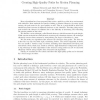Free Online Productivity Tools
i2Speak
i2Symbol
i2OCR
iTex2Img
iWeb2Print
iWeb2Shot
i2Type
iPdf2Split
iPdf2Merge
i2Bopomofo
i2Arabic
i2Style
i2Image
i2PDF
iLatex2Rtf
Sci2ools
108
Voted
IJRR
2007
2007
Creating High-quality Paths for Motion Planning
Many algorithms have been proposed that create a path for a robot in an environment with obstacles. Most methods are aimed at finding a solution. However, for many applications, the path must be of a good quality as well. That is, a path should be short and should keep some amount of minimum clearance to the obstacles. Traveling along such a path reduces the chances of collisions due to the difficulty of measuring and controlling the precise position of the robot. We describe a new technique, called Partial shortcut, which decreases the path length. While current methods have difficulties in removing all redundant motions, the technique efficiently removes these motions by interpolating one degree of freedom at a time. We also study two algorithms that increase the clearance along paths. The first one is fast but can only deal with rigid, translating bodies. The second algorithm is slower but can handle a broader range of robots, including three-dimensional free-flying and articula...
Algorithms | IJRR 2007 | Many Algorithms | Robots |
Related Content
| Added | 15 Dec 2010 |
| Updated | 15 Dec 2010 |
| Type | Journal |
| Year | 2007 |
| Where | IJRR |
| Authors | Roland Geraerts, Mark H. Overmars |
Comments (0)

